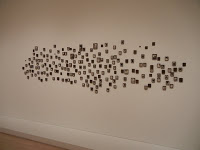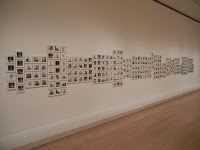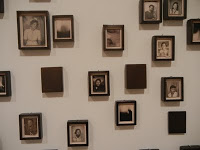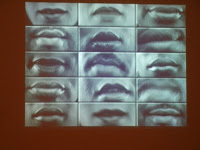JTF (just the facts): A total of 2 large installations and 1 video, hung along two long walls in a single room gallery space and in an adjacent darkened viewing area. One installation (57/09) consists of 308 small, square format gelatin silver prints, framed in white and matted, and hung in an undulating grid pattern. The second installation consists of 82 vintage photo booth prints and 68 small ink drawings, both framed in bronze, along with 30 solid bronze rectangles and 15 thinner bronze plates, arranged in a loose cluster. The video, Easy to Remember, consists of a grid of 15 mouths in black and white; it runs 2 minutes and 35 seconds. (Installation shots at right.)
Comments/Context: The three works in Lorna Simpson’s new show at the Brooklyn Museum all turn on the idea of cultural memory, of how past and present are often collapsed together and how our history is fully intertwined with our contemporary lives. It’s a powerful, sometimes haunting display that explores the universal nature of the passing of time, via its specific embodiment in the African-American experience.
In the first piece, Simpson has juxtaposed hundreds of 1950s amateur pinup photographs (found at flea markets and on eBay) with recent black and white self-portraits, recreating the specific poses, hairstyles and clothing with exacting mimicry. Both women talk on the phone, sit on benches, stand in the kitchen or near a TV, or sprawl invitingly on the floor. The mixing of old and new images and the constant repetition of twinned poses creates a strong back and forth rhythm. At first, I picked out the subtle differences between Simpson’s self-portraits (with an obvious edge of conceptual irony) and the genuine vintage photos; what is surprising is that after 50 or 60 images all tightly strung together, the context starts to dissolve away, and after another 100 or so, the contrasts become even more subtle, and they all merge together into an open-ended hybrid of past and present, reality and illusion. More than 50 years separates the lives of these two women, and yet, the connections are there; it’s like Simpson has created a kind of mirror that accounts for the changes in cultural context and perspective over time, but highlights the underlying commonality which remains.
 The second piece brings together faded and wrinkled photo booth portraits, washes of dark ink, and rectangles of bronze into a complex meditation on the nature of memory. Anonymous faces stare out from the photographs, offering tantalizing clues to lost personal stories (who were these people and what happened to them?). As time passes, these individuals alternately fade and darken, becoming abstract blots of dark ink, eventually transforming themselves into mute blocks of cool bronze. Taken together, the installation seems to document the subtle process of forgetting, where the lives and accomplishments of those who came before us slowly disappear; as more and more specific faces become unknown blocks, it becomes harder and harder to recreate our collective history.
The second piece brings together faded and wrinkled photo booth portraits, washes of dark ink, and rectangles of bronze into a complex meditation on the nature of memory. Anonymous faces stare out from the photographs, offering tantalizing clues to lost personal stories (who were these people and what happened to them?). As time passes, these individuals alternately fade and darken, becoming abstract blots of dark ink, eventually transforming themselves into mute blocks of cool bronze. Taken together, the installation seems to document the subtle process of forgetting, where the lives and accomplishments of those who came before us slowly disappear; as more and more specific faces become unknown blocks, it becomes harder and harder to recreate our collective history.
The video installation comes at the idea of memory from a different direction. 15 mouths hum the tune to the 1935 Rogers and Hart classic It’s Easy to Remember. The catchy melody will be instantly familiar to most, but the humming removes the actual lyrics, leaving behind a ghost of the song itself. Once again, Simpson has given us a fragmented shard of history, and then opened it up for a broad array of possible interpretations. I left the museum with the tune still stuck in my head, almost like a spooky undefined anthem.
Taken together, this is a thoughtful, understated, and quietly brilliant show about complex, interrelated cultural ideas and how time alters our perspective on these forces. And as a mark of something durably original, it has kept me thinking long after my trip to the museum.
Collector’s POV: Since this is a museum show, the works on view are obviously not for sale. Simpson’s photographs have only been intermittently available in the secondary markets in recent years, with prices ranging between roughly $1000 and $25000. As such, gallery retail is likely a better option for interested collectors at this point. The artist is represented by Salon 94 in New York (here).
.
Rating: ** (two stars) VERY GOOD (rating system described here)
.
- Artist site (here)
- Reviews: La Lettre de la Photographie (here), Snapshots (here), New Yorker (here), Brooklyn Paper (here)
Lorna Simpson: Gathered
Through August 21st
Brooklyn Museum
200 Eastern Parkway
Brooklyn, NY 11238








